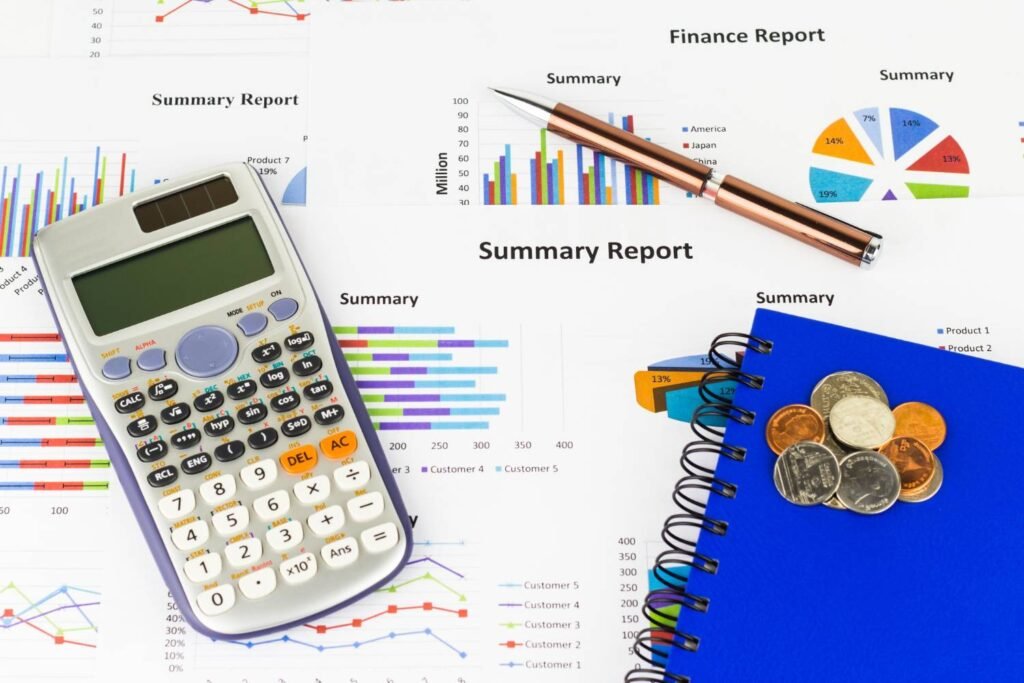What is Investing? (Best Guide for Beginners in 2024!)
According to this survey, 77% of Americans are anxious about their financial situation and 58% feel that finances control their lives. One key solution to this problem? Investing.
In this beginner’s guide, you’ll learn about investing, investment types and goals, risks when investing, best tips, common mistakes, and more.
I have curated all the information you need to understand and start investing today.
Table of Contents
Key Takeaways:
- Investing is when you put money into a venture with the expectation that it will grow over time.
- There are many different types of investments, including stocks, bonds, commodities, mutual funds, real estate, and exchange-traded funds (ETFs).
- To start investing, you need to educate yourself about the different types of investments and how they work. You also need to set SMART investment goals.
- There is no minimum amount of money that you need to start investing. You can start with as little as $5 or $10 in some cases.
- It is important to understand your risk tolerance before you start investing. Some investments are riskier than others, and you need to be comfortable with the amount of risk you are taking.
What is Investing?
Simply put, investing means letting your money work for you. It’s when you put money into a venture with the expectation that it will grow over time.
Here’s an example to help you understand the concept better:
Imagine you have $100 that you want to invest.
You can decide to buy shares in your favorite tech company. As that company grows and becomes more successful, the value of your shares increases too.
So, if you bought the shares at $10 each and they later went up to $20 each, your $100 investment would now be worth $200, and you would have made more money!
That’s investing in a nutshell – making your money work for you over time!
How Does Investing Work?
Still, you may wonder, “How do I put my money into a business, and then suddenly the money starts to grow? How does it happen? How does investing work?”
Investing works when you put your money into assets that have the potential to grow over time. Note the phrase “potential to grow”.
So how does it work?
When you invest, you essentially become a part-owner of a company, a lender to a government or corporation, or an owner of real estate.
A kind of investment, such as when you buy shares of a company’s stock, is like owning a small piece of that company. If the company does well and becomes more profitable, the value of your shares can go up, so you can sell them for more money than you paid.
If you invest in bonds, it’s like lending money to the government or a company. They pay you back the money you lent them plus extra money as interest.
So, it’s like getting paid regularly for letting them borrow your money, and when the bond reaches its end date, you get back the money you initially lent.
If you’re starting to get a little confused here, don’t worry. I’ll explain different kinds of investments to you soon.
What I’m trying to explain here is that it’s not magic. You put your money in a business that has the potential to grow, and as the business grows, so does your money.
Now that the point is clear, let’s look at how much you’ll need to start investing.
What is the Minimum Amount of Money Needed to Start Investing?
Short answer: There is no minimum amount of money that you need to start investing.
The minimum amount of money needed to start investing can vary depending on what you’re investing in and where you’re investing.
Does that mean you need a ton of cash to start investing? Not at all! In fact, you can start with as little as $5 or $10 in some cases!
For example, some online brokerage platforms like Charles Schwab allow you to start investing in stocks with as little as $0, while others may require a few hundred dollars to open an account. Many mutual funds have minimum initial investment requirements that can range from a few hundred to a few thousand dollars.
In short, the minimum amount you need to start investing depends on your goals, risk tolerance, and the investment options available to you. The key is to start with whatever amount you’re comfortable with and gradually increase your investments over time as you become more confident and financially able.
How to Start Investing in 2024?

By now you’re probably wondering where to begin investing.
Don’t worry, I’ve got you covered with a detailed step-by-step guide to help you invest and set yourself up for success.
Pick up your notebook and pen and let’s get started because you might want to write a few things down.
1. Educate Yourself
Before you jump into investing, it’s important to learn about the different ways you can invest your money and how they work. You can do this by reading books or articles (like the one you are reading) that explain investing in easy-to-understand language. So you’re already on the right track.
There are also online courses and workshops you can take, where experts teach you all about investing. For instance, you might want to check out a book like “The Little Book of Common Sense Investing” by John C. Bogle or take a beginner’s course on the stock market basics using websites like Coursera or Udemy.
This free course about financial markets (from Yale Univerity) and this one about investment management specializations are good places to start.
These resources will help you get a good grasp of the basics before you start making any investment decisions.
2. Set Clear and Realistic Investment Goals
Have you heard of the acronym SMART about goal-setting? It states that all goals must be Specific, Measurable, Achievable, Relevant, and Time-bound (SMART).
This means making sure you know exactly what you want, setting goals you can measure to see how you’re doing, making sure they’re things you can actually achieve, and making sure they matter to your bigger financial plans. Most importantly, don’t forget to set a timeline for when you want to reach each goal!
It’s easy to start thinking in millions when you start reading about investment opportunities and strategies, but setting unreasonable goals can lead to disappointment and an abandoning of your investment dreams altogether, which is something we do not want.
So how do you go about setting investment goals?
The key is to have different types of goals; short, medium, and long-term investment goals.
Short-term goals
For short-term goals, think about what you want to achieve within the next 1-3 years.
Let me illustrate:
In the short term, your goal could be to invest $5,000 in a high-yield dividend stock portfolio within the next year. This goal is specific as it outlines the exact amount and investment type.
It’s measurable because you’ll track your progress monthly to ensure you’re on target.
With careful budgeting and setting aside $400 from each paycheck, this goal is achievable without straining your finances.
It’s relevant to your overall financial strategy as it aims to generate passive income while you focus on your career and it is time-bound, as you plan to achieve this goal within one year to start reaping the benefits of dividend payouts sooner rather than later.
Medium-term goals
Medium-term goals generally span 3-7 years.
So continuing our example, you could say, looking ahead, your medium-term goal involves diversifying your investment portfolio by purchasing rental property within the next 3 to 5 years (we’ll talk more about how to diversify your portfolio soon).
This goal is specific as it specifies the type of investment and timeframe. It’s measurable as you’ll track your savings progress monthly to gather the necessary down payment. Achieving this goal is realistic as you’ll put aside additional income from your side hustle towards the down payment while still meeting your other financial obligations.
It’s relevant as investing in real estate aligns with your long-term goal of building wealth for financial independence and finally it is time-bound, as you aim to purchase the rental property within 3 to 5 years to take advantage of potential market opportunities.
Long-term goals
Long-term goals generally extend beyond 7 years. Therefore looking further ahead, your long-term goal could be to have a $2 million retirement portfolio by age 65.
This goal is specific, outlining the desired portfolio size and retirement age. It’s measurable as you’ll regularly monitor your retirement accounts and investment growth to ensure you’re on track. Achieving this goal is realistic through consistent contributions to retirement accounts and strategic investment decisions.
This goal is relevant as securing a comfortable retirement is vital for maintaining financial independence and enjoying your later years and it is time-bound, as you have set a deadline of age 65 to reach this milestone, allowing for ample time to make necessary adjustments along the way.
By SMARTly handling your investments over various time periods, you can work towards multiple goals at once and increase your chances of financial success.
3. Determine Your Risk Tolerance

Risk tolerance? What is that- you may ask. The truth is, no investment is risk-free (more on this later).
So your risk tolerance is a measure of how much uncertainty (ups and downs) you can handle without feeling uncomfortable or making impulsive decisions.
Someone with a higher risk tolerance is generally more comfortable with taking on greater investment risks to gain higher potential returns, while someone with a lower risk tolerance prefers safer, more conservative investments to minimize the chance of losses.
To determine your risk tolerance, you can start by asking yourself some questions:
What is your investment timeframe?
Short-term goals may call for more conservative investments, while long-term goals may allow for more risk.
How would you feel if your investment lost value in the short term?
If you lose sleep over it, you may have a lower risk tolerance.
What is your overall financial situation?
If you have a stable income and emergency savings, you may be more comfortable with taking on some investment risk.
Additionally, there are risk tolerance questionnaires available through financial advisors and online investment platforms that can help you estimate your comfort level with investment risk based on your responses to various scenarios and questions.
Check out these risk tolerance quizzes from the University of Missouri and Vanguard.
Knowing your risk tolerance helps you pick investments that match how much risk you’re comfortable with.
4. Select Your Investment Type(s) or Vehicle(s)
An investment type or vehicle refers to the method or tool you use to invest your money. More technically, it is the specific asset or financial product in which you invest your money with the expectation of generating a return.
Examples of investment types or vehicles include options such as stocks, bonds, mutual funds, exchange-traded funds (ETFs), real estate, commodities, and more (there’s a detailed explanation of each of these investment vehicles below).
What you need to understand is that each investment vehicle carries its own level of risk, potential return, and investment duration. For example, stocks tend to come with higher risks but they also have higher returns, while government bonds can be a more steady reliable income source.
Asking yourself these questions can help you determine which investment type is best for you according to your needs and goals.
- What are my investment goals? (e.g., saving for retirement, buying a house, funding education)
- What is my investment timeframe? (short-term, medium-term, or long-term)
- What is my risk tolerance? (how comfortable am I with the possibility of investment losses)
- How much capital do I have to invest?
- What is my knowledge of different investment options?
- What level of involvement do I want in managing my investments? (active vs. passive investing)
- How important is diversification to me? (spreading investments across different asset classes
5. Calculate How Much Money You Want to Invest

This is the part where you have to do the math. These are the factors you need to consider before you can calculate the amount of money you want to invest.
1. Investment Goals
Determine the specific financial goals you want to achieve through your investments, such as saving for retirement, purchasing a home, or funding a child’s education.
2. Time Horizon
Consider the timeframe over which you want to achieve your investment goals, whether they are short-term (1-3 years), medium-term (3-7 years), or long-term (7+ years).
3. Risk Tolerance
Evaluate your comfort level with investment risk, as it can influence the amount you are willing to invest in potentially higher-return but riskier assets.
4. Existing Financial Commitments
Take into account your existing financial obligations, such as debt repayments, living expenses, and emergency funds, before deciding on the amount to invest.
When you’re clear on these factors, you can make your calculations. You can use this example as a guide;

Let’s create a goal of saving for a down payment on a house.
The median home price in the United States is around $350,000. A common down payment percentage is 20% of the home’s purchase price, which amounts to $70,000.
Now, let’s assume you want to purchase a house in five years.
To calculate how much you need to invest each month to reach this goal, we’ll use a straightforward formula:
Monthly Investment = Total Amount Needed/ Number of Months
In this case, the total amount needed is $70,000, and the number of months is 60 (5 years x 12 months).
Monthly Investment = $ 70,000/60
Monthly Investment =$1,166.67
So, you would need to invest approximately $1,166.67 per month for five years to save $70,000 for the down payment on a house.
Of course, this calculation assumes that you’ll put away the same amount of money every month for five years. But remember, things might change along the way. Your income could go up or down, and unexpected expenses might pop up.
Plus, the housing market can be unpredictable. So, it’s a good idea to review your plan regularly and adjust it as needed. Maybe you’ll need to save a bit more each month, or maybe you’ll get lucky with some investment gains.
When it comes to calculating the amount you want to invest, the key is to stay flexible and keep an eye on your progress to make sure you’re on track to reach your goals!
6. Diversify Your Portfolio
An investment portfolio is like a collection of different types of investments you own, kind of like a mix of ingredients in a recipe. Each investment, like stocks, bonds, or real estate, has its own characteristics and potential for return and risk.
What does it mean to diversify your investment portfolio? It’s simply to spread your investments across different types of assets to reduce the risk.
Imagine putting all your money into just one stock, like betting everything on a single horse in a race. If that horse stumbles and falls, you’re left empty-handed! That’s what happens when you don’t diversify your portfolio. It’s like having all your eggs in one basket—drop the basket, and you’re out of luck!
By putting together a diverse portfolio, you spread out your risk.
How do you diversify your portfolio?
The following tips will show you the best way to do this;
1. Invest in Different Types of Assets
Instead of putting all your money in one place, spread it out across various types of investments.
For instance, imagine you have $10,000 to invest. Instead of investing the entire amount in just one thing, like buying shares of a single company’s stock, you could diversify your investments.
You might decide to put $4,000 in stocks of different companies from various industries, $3,000 in bonds issued by governments or corporations, $2,000 in a real estate investment trust (REIT) that owns properties like shopping malls or apartments, and $1,000 in commodities like gold or silver.
This way, if one investment doesn’t perform well, the others may still do okay, helping to balance out your overall returns and reduce the risk of losing all your money.
2. Choose Different Industries
Invest in companies from different industries to reduce risk.
For example, let’s say you own some tech stocks in your investment portfolio. Tech stocks can offer high growth potential, but they can also be very risky. To mix things up and make your investment safer, you might want to add some healthcare or consumer goods stocks.
Healthcare companies, like pharmaceutical or biotech firms, often perform differently than tech stocks and can provide stability during times when the tech sector is shaky. Similarly, consumer goods companies, such as those producing household products or food items, tend to be less affected by changes in technology trends and can offer steady returns.
3. Invest in Different Geographical Regions
Spread your investments globally to reduce the impact of regional economic downturns. If you only invest in companies based in the United States and there’s an economic downturn in the U.S., all your investments could be affected.
But if you invest in companies from Europe, Asia, and other regions as well, the impact of a downturn in one region might be offset by growth or stability in another. So, by diversifying globally, you’re less likely to lose money if one country’s economy isn’t doing well.
4. Consider Different Investment Vehicles
Buying mutual funds or exchange-traded funds (ETFs) is a great way to achieve instant diversification.
Let me explain; A mutual fund might include a mix of stocks, bonds, and other investments from different industries. Likewise, an ETF that follows a big stock market index, like the S&P 500, gives you a diverse range of stocks from many companies and sectors all at once.
What this means is, that when you make a single purchase, you’re not putting all your money into just one type of investment or company. Instead, you’re spreading it out across lots of different sectors at the same time.
Plus, mutual funds and ETFs are managed by experts who decide where to invest the fund’s money, so you don’t have to worry about picking individual stocks yourself. You have a team of professionals investing your money for you.
7. Start Small and Stay Consistent
At this point, you may be thinking, “I’m not earning so much money, but these investment options seem huge and overwhelming!” Don’t worry; you’re not alone. Many people feel this way when they’re just starting out.
The good news is that you don’t need a lot of money to begin investing. Even if you can only spare a small amount each month, like $50 or $100, you can still start building your investment portfolio. The key is to start small and stay consistent.
Even small, regular contributions can grow a lot over time thanks to the power of compounding. For instance, putting a little money each month into a low-cost index fund or retirement account can slowly but steadily build up your wealth in the long term.
By starting with just a little bit of money and keeping at it, you can slowly build up your investment portfolio, even if money’s tight. As you start earning more, you can think about putting more money into your investments to speed up your journey to building wealth.
8. Monitor and Adjust Your Portfolio

If you want to gain the maximum benefits from your investments, you need to monitor and adjust your portfolio. What that means is that you should regularly check how your investments are doing.
You can do this by logging into your investment accounts online or using a mobile app. For instance, let’s say you’ve invested in a mix of stocks and bonds. After a few months, you notice that the stocks are doing really well and have grown to make up a larger part of your portfolio than you initially planned.
This might make your portfolio riskier than you’re comfortable with. In this case, you might decide to sell some of your stocks and use the money to buy more bonds, bringing your portfolio back into balance.
In the same way, if one of your investments consistently underperforms compared to others, you might choose to sell it and invest in something else that you believe will perform better.
By regularly reviewing your investments and making adjustments as needed, you can ensure that your portfolio stays on track to meet your financial goals.
Common Types of Investments
As a beginner investor, you need a clear understanding of the various types of investments. I’ll keep the explanations as simple as possible. I’ll also add the level of risk and potential returns of each investment type.
Let’s explore each of these investment types so you can understand them better.
1. Stocks
When you buy stocks, you’re purchasing shares of ownership in a company. If the company does well, your shares can be worth more, so you can sell them for a profit.
For instance, if you buy stocks of a tech company like Apple or Microsoft, you’re hoping they’ll grow and innovate. Stocks can bring big returns, but they’re also risky. You’re betting on the company’s success.
If it does well, your stocks go up, and you make money. But if the company struggles, your stocks can lose value, and you might lose money. Overall, stocks can offer high returns, but they also carry a higher risk of loss.
Risk level: Medium to high
Potential returns level: High
Potential losses level: High
2. Bonds
Bonds work like loans. When you buy a bond, you’re lending money to either a government, municipality, or a company. In return, they pay you interest regularly, called coupon payments, and give you back the full amount you lent them when the bond matures.
Bonds usually have set interest rates and end dates, so you’ll know exactly when they’ll get their money back. For instance, if you buy a bond from the U.S. government, they’ll pay you interest every six months until the bond matures, at which point they’ll return the full amount you invested.
Risk level: Low to medium
Potential returns level: Low to medium
Potential losses level: Low
3. Commodities
Commodities are physical, essential everyday life goods like grains, metals (gold or silver), and energy sources(crude oil) that are traded on special markets called commodity exchanges.
You can use different methods to buy commodities:
1. Futures Contracts
These are agreements to buy or sell a commodity at a set price on a certain future date. Futures contracts allow investors to profit from anticipated price movements in commodities without needing to own the physical goods.
I know you are probably lost, so let me explain.
Let’s say you’re an investor interested in crude oil. You believe that the price of oil will increase in the next few months due to increasing global demand. Instead of purchasing barrels of oil directly, you decide to enter into a futures contract for oil.
You buy 100 barrels of oil at the current price of $60 per barrel, with delivery in three months. This means you’ve agreed to purchase oil at $60 per barrel in three months, regardless of whether the market price has risen or fallen.
Now, suppose that after three months, the market price of oil has risen to $70 per barrel. Since you’ve locked in the price at $60 per barrel in your futures contract, you can buy the oil at the agreed-upon price and immediately sell it at the higher market price of $70 per barrel. This results in a profit of $10 per barrel.
On the other hand, if the price of oil had fallen to $50 per barrel, you would still be obligated to buy the oil at $60 per barrel as per the futures contract. In this case, you would incur a loss of $10 per barrel compared to the market price.
2. Exchange-Traded Funds (ETFs)
ETFs, when it comes to commodities, are funds that contain a mix of commodities or related assets.
For instance, predictions say the gold price, currently at $2400, will go above $4000 between 2024 and 2030. If you’re interested in investing in gold but don’t want to deal with the hassle of buying and storing physical gold, you can decide to invest in a gold ETF that trades on a commodity exchange.
This gold ETF holds physical gold bullion in its portfolio to track the price of gold. When you buy shares of this ETF, you’re essentially buying a piece of the gold held by the fund.
Then, if the price of gold increases, the value of your ETF shares will likely go up too, allowing you to profit from the gold’s price appreciation without needing to handle the physical gold yourself. Similarly, if the price of gold decreases, the value of your ETF shares may decline, but you’re not directly exposed to the risks associated with owning physical gold.
3. Physical Ownership
Some investors prefer owning actual commodities like gold, oil, or crops. They might buy gold bars, barrels of oil, or bushels of wheat. However, storing physical commodities can be tricky and expensive, requiring secure storage facilities and transportation arrangements.
For example, suppose you’re interested in investing in silver and decide to opt for physical ownership. You purchase a certain quantity of silver bars or coins from a reputable dealer or mint.
Once you’ve acquired the physical silver, you need to store it securely. You might choose to keep it in a safe at home, rent a secure storage facility, or use a third-party custodian service. You could purchase 100 ounces of silver bars and store them in a secure safe in your home.
With physical ownership, you directly own the silver, and its value fluctuates with market prices. If the price of silver rises, the value of your physical silver holdings increases, allowing you to potentially profit when you decide to sell. On the other hand, if the price of silver falls, the value of your investment decreases.
Risk level: Moderate to High
Potential returns level: Moderate to High
Potential losses level: Moderate to High
4. Mutual funds
Mutual funds are investment vehicles that pool money from multiple investors to purchase a diversified portfolio of stocks, bonds, or other securities. They are like a group investment where many people put their money together to invest.
These funds are managed by professional portfolio managers, who make investment decisions on behalf of the investors. They’re good for people who want to invest but don’t have lots of money or know-how.
For instance, the Vanguard Total Stock Market Index Fund is one such mutual fund. It tries to match how well the whole U.S. stock market is doing by investing in lots of different U.S. companies. People can buy shares in this fund to own a bit of the entire U.S. stock market. It’s managed by Vanguard Group, which is a big company that handles investments.
Risk level: Low to High (depends on the type of mutual fund)
Potential returns level: Low to High (depends on the performance of the underlying investments)
Potential losses level: Low to High (depends on the performance of the underlying investments)
5. Real Estate

Real estate investments involve purchasing properties to generate income or increase their value over time. For instance, you can buy property—a house or an apartment building and earn income by renting out the property to tenants who pay you monthly rent.
Over time, as property values increase, the value of your investment grows, allowing you to sell the property for a profit. Additionally, you can renovate or improve the property to increase its rental income or resale value.
Real estate investments can also involve purchasing commercial properties like office buildings or retail spaces and leasing them to businesses.
Before putting money into real estate, it’s vital to do your homework, check your finances, and maybe talk to financial experts. Also, take a close look at the local real estate scene, property condition, rental demand, and expected profits to see if it matches what you want and how much risk you’re comfortable with.
Risk level: Moderate to High (depending on factors like location, market conditions, and property type)
Potential returns level: Moderate to High (through rental income, property appreciation, and tax benefits)
Potential losses level: Moderate to High (due to factors like property vacancies, market fluctuations, and maintenance costs)
6. Exchange-traded funds (ETFs)
If you really want to diversify your portfolio, ETFs are the way to go. Why is that? ETFs contain a mix of investments such as stocks, bonds, commodities, or a combination of these. Imagine you’re interested in investing in technology companies but don’t want to pick individual stocks. Instead, you can invest in a technology ETF.
This ETF holds a bunch of tech-related stocks, like Apple, Microsoft, and Google. When you buy shares of this ETF, you’re essentially buying a small piece of all these companies. So, if the tech sector does well, the value of your ETF shares goes up, allowing you to profit.
Conversely, if the tech sector struggles, your investment may decline, but since it’s spread across many companies, the impact isn’t as severe. Diversifying in this manner helps you manage risk while still offering potential for growth.
Risk level: Moderate (depending on the assets held within the ETF)
Potential returns level: Moderate to High (depending on the performance of the underlying assets)
Potential losses level: Moderate to High (depending on market conditions and the assets held within the ETF)
7. Treasury Securities
Treasury securities are a type of bond. Specifically, however, they are bonds issued by the U.S. Department of the Treasury. So, when you hear people refer to Treasury securities, they are essentially talking about U.S. government bonds.
These securities come in various forms, including Treasury bills (T-bills), Treasury notes (T-notes), and Treasury bonds (T-bonds), each with different characteristics such as maturity periods and interest payment frequencies.
How do treasury securities work?
- You decide to purchase a Treasury bond directly from the U.S. government.
- Let’s assume this bond has a face value of $1,000 and a maturity period of 10 years.
- The government promises to pay you regular interest payments, known as coupon payments, every six months until the bond matures.
- At the end of the 10-year period, the government will return the $1,000 face value to you.
- If the bond has an annual interest rate of 3%, you’ll receive $30 in interest payments each year ($1,000 x 3%).
- After 10 years, you’ll have received a total of $300 in interest payments, in addition to getting back the $1,000 face value.
Risk level: Low (considered one of the safest investments due to the backing of the U.S. government)
Potential returns level: Low to Moderate (typically offer lower returns compared to riskier investments but provide a stable income stream)
Potential losses level: Low (minimal risk of default, but may experience losses due to changes in interest rates or inflation)
8. Cryptocurrencies

Cryptocurrencies are a special kind of currency, a digital currency. This means it’s not like the coins or bills you’re used to. It’s all online.
They work on a system called blockchain, which is like a big digital ledger shared by lots of people. This means no one person or organization controls them. Instead of being controlled by banks or governments, they’re managed by the people who use them.
The most famous cryptocurrency is Bitcoin, but there are many others, each with different purposes and features.
There are many different ways to profit from trading cryptocurrency, a few of those include;
1. Price Appreciation
Suppose you purchase Bitcoin (BTC) at $10,000 per coin and hold it for some time. If the price of Bitcoin increases to $20,000 per coin, you can sell it for a profit of $10,000 per coin. Similarly, if you invest in a lesser-known cryptocurrency like Ethereum (ETH) at $300 per coin and its price rises to $3,000 per coin, you can sell it for a significant profit.
2. Trading Activities
Active traders can engage in various trading activities to profit from short-term price fluctuations in the cryptocurrency market. This includes margin trading, where traders borrow funds to amplify their trading positions, futures trading, where traders speculate on the future price of cryptocurrencies, and arbitrage, where traders take advantage of price differences between different exchanges or trading pairs to make a profit.
It is important to note that investing in cryptocurrency can be very high risk. The market is volatile, there is regulatory uncertainty, and you may face some technological problems.
My advice before you invest in cryptocurrency is to do your research well, understand how it works and the risks involved, and select a reputable cryptocurrency so that you can reduce your risk as much as possible and keep yourself updated on cryptocurrency news as that can guide your investment decisions.
Risk level: High
Potential returns level: High
Potential losses level: High
9. Options and Other Derivatives
Options and other derivatives are investment vehicles that give you the flexibility to profit from price movements in the underlying assets without directly owning them. Options offer investors the right to buy or sell an asset at a set price within a specific time frame.
For instance, if you think a stock will go up, you might buy a call option to purchase it later at a lower price. If the stock’s value rises as expected, you can buy it at a lower price and sell it for a profit. However, if the stock’s value doesn’t rise as anticipated, you can choose not to buy it and only lose the premium paid for the option.
Other derivatives, like futures contracts or swaps, also let you agree to buy or sell something in the future at a price decided today. You can use these to protect against risks, make bets on future prices, or manage your investments in markets.
Risk level: High
Potential returns level: High
Potential losses level: High
10. Certificates of Deposit (CDs)
Certificates of deposit (CDs) are like savings accounts you open with banks or credit unions, where you agree to leave your money for a set period, from a few months to a few years, at a fixed interest rate. In return, the bank pays you interest on the money you’ve deposited.
CDs are known for being low-risk because they’re insured by the Federal Deposit Insurance Corporation (FDIC), meaning your money is safe even if the bank fails.
However, they usually offer lower returns compared to riskier investments like stocks or mutual funds. When the CD matures, you can take out your initial deposit plus the interest earned. But if you withdraw your money before the maturity date, you might have to pay penalties or lose some of the interest you’ve earned.
Risk level: Low
Potential returns level: Low
Potential losses level: Low
What Investment Type is Good for You?
The best investment type depends on your individual financial circumstances, goals, and risk tolerance. My recommendation would be to consider consulting with a financial advisor to help you create a personalized investment strategy tailored to your needs.
However, you could determine what investment type will be best for you by answering the following questions: What are your financial goals? What is your risk tolerance? What is your investment timeline? What is your financial situation?
Based on your answers to these questions, here are some investment-type suggestions;
Low Risk, Short-Term Goals:
You might want to put your money in Certificates of Deposit (CDs) or high-yield savings accounts. These choices are safe and promise to give you back your money plus a little more, which makes them good for short-term goals like saving up for a trip or having money ready for emergencies.
Long-Term Growth, Moderate Risk Tolerance
Mutual funds or Exchange-Traded Funds (ETFs) that follow big market indexes like the S&P 500 could be good for long-term growth. These investments spread your money across lots of different assets, so if one doesn’t do well, the others might balance it out. They’re good if you’re okay with a medium amount of risk and want to grow your money over many years, like saving up for retirement.
Higher Risk Tolerance, Potential for High Returns
If you’re comfortable with higher risk and seeking the potential for high returns, consider investing in individual stocks or growth-oriented mutual funds. These investments have the potential for significant growth but also come with higher volatility and the risk of potential losses.
Tax-Efficient Investing
If you want to save on taxes while investing, look into accounts like IRAs or 401(k)s. They give you special tax breaks, so your money can grow without getting hit with a big tax bill. Also, consider investing in assets like municipal bonds or special mutual funds that are managed to save on taxes. These can help you keep more of your investment earnings in your pocket.
Hands-Off Approach, Professional Management
On the other hand, if you’d rather not get too involved in managing your investments, you can try using robo-advisors or hiring a financial advisor. Robo-advisors are like digital investment helpers who use algorithms to manage your portfolio.
They build and manage your investment mix based on your goals and how much risk you’re comfortable with. Or, you could go the traditional route and work with a human financial advisor. They’ll give you personalized advice and take care of managing your investments for you.
What is the Best Investment Strategy for Beginners?

The ‘Buy and Hold’ strategy is one of the best strategies for beginners. Since you are now starting out on the fundamentals of investing, it’s a good idea to choose an investment strategy that requires less active management.
So even though there are many investment strategies you can go with, I recommend starting with one that is simpler and less risky to build a solid foundation.
Buy and Hold Strategy
This is one of the most straightforward approaches for beginners. Here’s how it works: you invest your money in well-known and well-established companies or index funds and then just hang onto them for a long time.
The buy-and-hold strategy is best for beginners because it’s easy to understand and requires less active management. You don’t have to worry about constantly checking the market or making quick decisions. Just invest in solid companies or index funds and let your money grow over time.
Let me demonstrate how the buy-and-hold strategy works with this example;
- You buy 100 shares of Coca-Cola stock at $50 per share, totaling $5,000.
- Instead of constantly monitoring the stock’s price and trying to time the market, you hold onto your shares for the long term, regardless of short-term fluctuations.
- Over the years, Coca-Cola has continued to grow as a company, and its stock price gradually increased. After five years, the stock price has risen to $75 per share.
- At this point, you have the option to sell your shares for a profit. However, since you’re following the buy-and-hold strategy, you decide to continue holding onto your Coca-Cola shares, confident in the company’s long-term growth prospects.
- Throughout the holding period, Coca-Cola pays regular dividends to its shareholders. Instead of cashing out these dividends, you choose to reinvest them back into more Coca-Cola shares, further increasing your investment over time.
How Can You Tell if a Particular Investment is a Good Opportunity?
You can tell if an investment is good by doing research, checking its past performance, and talking to experts. Also, think about how it fits into your overall investment plan. If it matches your needs and you’re comfortable with the risks, it could be a good opportunity for you.
The following questions can help you determine if a particular investment is a good opportunity for you;
- What is the investment’s potential return, and how does it align with my financial goals?
- What are the associated risks, and am I comfortable with the level of risk involved?
- What are the current market conditions, and how might they impact the investment’s performance?
- How does this investment fit into my overall investment portfolio and strategy?
- What is the investment’s liquidity, and how easily can I buy or sell it if needed?
- What are the fees and expenses associated with the investment, and how do they affect its overall return?
- What is the investment’s track record and historical performance?
- What are the tax implications of the investment, and how might they affect my after-tax returns?
- Are there any regulatory or legal considerations I need to be aware of?
- How does this investment compare to alternative investment opportunities available to me?
7 Investment Risks to Remember
1. Market risk
Market risk means you might lose money when the overall market changes. For example, during a recession, when the economy slows down, stock prices can drop because people spend less money and businesses struggle.
Also, events like trade disputes between countries can make the stock market uncertain, causing prices to go up and down. If you’ve invested a lot in stocks, you could see your investments lose value when these things happen.
2. Business risk
Business risk means the chance of losing money because of problems specific to a company or industry. For example, if a company operates in a market where lots of new competitors can easily enter, it might struggle to make profits. In addition, if people’s preferences change, or if there are big advances in technology, a company might find it hard to stay successful.
For instance, if a store doesn’t change how it sells things as people start shopping online more, it could lose business. So, if you own stock in a company facing these kinds of problems, the value of your investment might drop.
3. Interest rate risk
Interest rate risk means the chance of losing money because interest rates change. If interest rates go up, the value of bonds you already own goes down because newer bonds offer higher interest rates. But if interest rates drop, the value of your bonds goes up because they pay higher interest rates than new ones.
For example, let’s say you own a bond with a 3% interest rate, and then interest rates rise to 4%. Your bond isn’t as attractive to buyers anymore because they can get newer bonds with higher interest rates. So, if you decide to sell your bond early, you might have to sell it for less money than you paid for it, which means you lose money.
4. Inflation risk
Inflation risk in investing means that your investment might not grow enough to keep up with the rising cost of living. For instance, if you put your money in things like bonds or savings accounts that give fixed returns, and prices start going up due to inflation, your investment might not be worth as much in real terms.
Even if the numbers in your account look bigger, they might not buy as much as they used to because prices have gone up. So, it’s smart to invest in things like stocks or real estate that have a better chance of growing faster than inflation. That way, you can protect your purchasing power and maybe even make more money over time.
5. Liquidity risk
Liquidity risk implies that sometimes you might not be able to sell what you’ve invested in very quickly or for the right price.
For instance, if you invest in something like a house or a rare item, it could take a long time to find someone willing to buy it, especially if not many people are looking to buy at that time. So, you might have to sell it for less money than you’d hoped, or you might not find a buyer at all.
This could be a problem if you suddenly need cash or if you want to sell your investment to buy something else. That’s why it’s smart to think about how easy it would be to sell what you’re investing in before you decide to invest.
5. Credit risk
Credit risk means there’s a chance the person or company you lend money to might not pay you back as promised. For instance, if you loan money to a friend and they don’t repay you, that’s credit risk.
Likewise, if you buy bonds from a company that goes bankrupt, you might not get the interest payments or the full amount you invested. It’s important to consider this risk because it could lead to losing money on your investment.
6. Currency risk
Currency risk refers to the potential for losses due to fluctuations in exchange rates when you invest in assets denominated in a foreign currency. What this means is that you stand the chance of losing money because the value of the money you invested changes compared to the money you use every day.
Let’s say you buy stocks or bonds from a company in another country. If the money in that country becomes less valuable compared to your own money, you might lose money when you change it back. But if the foreign money becomes more valuable, you could make a profit when you change it back. This risk is a big deal for people who invest in other countries or use different currencies.
7. Political risk
This is the risk that political decisions or events can affect the value of your investments. For instance, if a country makes new rules that limit foreign investment, it could hurt investments there.
Also, if there’s political unrest or conflict in an area, it can make financial markets uncertain and cause investment values to fluctuate.
Risk Management Is Key When Investing
All investments come with a certain degree of risk. When you invest, there’s always a chance that you could lose some or all of your money. That is why it is important to manage risk.
When you employ risk management techniques, it helps you balance the potential for returns with the level of losses.
Let’s discuss a few of these risk management strategies;
What are some effective risk management strategies?
1. Diversification
When you diversify, you spread your investments across a variety of assets, stocks, bonds, commodities, and more so if one investment doesn’t do well, the overall impact is lessened.
For instance, instead of putting all your money into one tech company’s stock, you decide to split it equally among three different sectors: technology, healthcare, and consumer goods. This way, if the technology sector experiences a downturn, your investments in healthcare and consumer goods may still perform well, helping to offset any losses.
2. Asset Allocation
This strategy involves deciding how much money you want to put into different types of investments. So how much do you want to invest in stocks, bonds, or real estate? The amount you choose to allocate to each asset will depend on how comfortable you are with taking on risk and your investment goals.
If you’re younger you may be willing to allocate more of your investments into stocks, which can be high risk. But if you’re closer to retirement and want to protect your money you might put more into bonds, which are generally safer.
A well-structured asset allocation strategy can help manage risk by balancing the potential return and risk level of your overall portfolio.
3. Setting Stop-loss Orders
Stop-loss orders are a safety net that you can put under your investments to reduce risk. With setting stop-loss orders, you decide ahead of time the price at which you’ll sell an investment to prevent big losses.
For example, if you own a stock now worth $50 per share, you could set a stop-loss order at $45 per share. If the stock price falls to $45 or lower, your shares are sold automatically. This helps you stop losing more money.
4. Regular Portfolio Rebalancing
Regularly rebalancing your portfolio involves regularly checking on your investment mix to see if it still matches your investment goals and potential returns. If you decided to put 60% of your money into stocks and 40% into bonds.
If the stock market does really well and your stocks become worth a lot more, you might end up with more than 60% of your money in stocks. This could be risky. So, to balance things out again, you might sell some stocks and use that money to buy more bonds. This way, you keep your investments in line with your original plan.
5. Emergency Fund
An emergency fund in investing refers to a portion of your savings kept readily available in cash or highly liquid assets, separate from your investment portfolio, to cover unforeseen expenses or financial emergencies.
For instance, let’s say you’ve been diligently investing in stocks and bonds for your retirement. Suddenly, your car breaks down, and you need $1,000 for repairs. Instead of selling some of your investments, which might incur losses if the market is down, you can use the money from your emergency fund to cover the repair costs.
This way, your long-term investments remain untouched, allowing them to continue growing without interruption.
5 Investment Tips for Beginners

We’re now at the part where I share my tips with you. These valuable tips are going to help you embark on your investment journey with confidence;
1. Open a brokerage account
This tip right here is a key to beginner investing that many may not tell you about but it could be your key to growing wealth.
What is a brokerage account?
A brokerage account is like a bank account but for buying and selling investments like stocks, bonds, and funds. It’s offered by companies called brokerage firms, which help you trade in financial markets. With a brokerage account, you can make investment deals, keep track of your investments, and use different services provided by the brokerage firm.
Some of the best and most popular brokerage platforms include Robinhood, TD Ameritrade, Charles Schwab, and Fidelity offer user-friendly interfaces and diverse investment options suitable for beginners.
Why open a brokerage account?
You need to open a brokerage account because it’s the gateway to investing. Think about it this way, with a brokerage account, you can buy and sell investments (stocks, bonds, and other assets) easily, access a wide range of financial products, and take advantage of investment opportunities in the market.
How do you open a brokerage account?
The steps to open a brokerage account differ for each platform but there are certain general guidelines.
Step 1: Research and Choose a Brokerage Firm
Research different brokerage firms to find one that meets your investment needs offers the services you require, and has a fee structure that aligns with your investment style.
The most popular ones are;
- Charles Schwab
- Fidelity Investments
- TD Ameritrade
- Interactive Brokers
- Robinhood
- Vanguard
- Merrill Edge
- Ally Invest
- TradeStation
While Fidelity is one of the best overall brokerage firms with low costs, I recommend Charles Schwab for beginners. The user interface is super friendly, and there is no minimum investment limit, so you can start with whatever amount you have. In addition, opening and maintaining a Schwab account is entirely free of charge. It is also a highly respected financial institution that you can trust.
Step 2: Gather Required Documents

Prepare necessary documents such as identification (driver’s license, passport), Social Security number, and proof of address (utility bills, bank statements) beforehand.
Double-check that these documents are up-to-date and match the information you’ll provide on the application form. If you’re unsure about which documents are needed, reach out to the brokerage firm’s customer service for guidance.
Step 3: Select Account Type
Decide on the type of brokerage account you want to open, such as a cash account, margin account, retirement account (e.g., IRA), or education savings account (e.g., 529 plan).
For beginners, a cash account might be a good starting point, as it allows you to invest using only the funds you have available.
Other options, like margin accounts, retirement accounts (like IRAs), or education savings accounts (like 529 plans), might suit you better depending on your goals and how much risk you’re comfortable with. Make sure you understand each account’s features before you decide.
Step 4: Complete the Application
Visit the brokerage firm’s website or contact them to request an account opening application. Alternatively, many brokerage firms offer online account opening processes.
When completing the application, make sure to provide accurate personal information, including your full name, address, date of birth, and Social Security number. Also, be prepared to disclose your financial details, such as your income, employment status, and investment experience.
Here’s a tip for beginners: Take your time and read each question carefully. If you’re unsure about any information or investment terms, don’t hesitate to ask for clarification from the brokerage firm’s customer service team.
Step 5: Deposit Funds
Once your account is approved, you’ll need to fund it. Depending on the brokerage, you may be able to transfer funds electronically from your bank account or mail a check.
Beginner tip: When putting money into your brokerage account, start with a small amount first. This helps you get used to using the account without risking too much money, then you can keep increasing it when you start to get more comfortable with
Make sure you understand how to add money to your account(funding options), like using electronic transfers or sending a check by mail. Follow the instructions from the brokerage to avoid any problems. Again, if you’re unsure about anything, ask the brokerage’s customer service for help, they’ll be happy to assist you.
Step 6: Review and Sign Agreements
Review and sign all required agreements and documents, such as the customer agreement, margin agreement (if opening a margin account), and any other disclosures.
Before signing any agreements, take the time to carefully review all the documents provided by the brokerage. Make sure you understand the terms and conditions, including any fees, account minimums, and important policies.
If you’re unsure about anything, don’t hesitate to ask questions or seek clarification. My tip is for you to make sure you fully understand what you’re agreeing to before finalizing the account opening process.
Step 7: Choose Investments
Once your account is funded, you’re ready to begin investing. Consider starting with simpler investments like mutual funds or ETFs, which offer diversification with less risk. As a beginner, it’s important to start with these safer investments and gradually increase your investment knowledge and risk tolerance over time.
Step 8: Set Up Security Features
Ensure that you set up security features such as two-factor authentication and a strong password to protect your account.
The danger of not setting up proper security features for your brokerage account is that it becomes vulnerable to unauthorized access and potential hacking attempts. This lack of security could result in financial losses and compromise your personal information.
2. Do Your Research
The next tip I have for you is that before you invest your money, make sure to do your homework.
Spend time researching different types of investments like stocks, bonds, mutual funds, ETFs, and real estate. Understand how each one works and what risks are involved. You can find lots of information online, in financial news, and through educational resources.
For example, learning about how to analyze stocks or how changes in interest rates affect bond prices can help you make smarter investment choices.
3. Start small and scale gradually
My next tip for you is to start small. Since you’re just starting out, it’s smart to begin with small investments that won’t hurt your finances too much if things don’t go as planned.
Think about putting your money into things like index funds or ETFs, which spread your investment across lots of different companies and have low fees.
Start with an amount you’re comfortable with, like $100 a month, and slowly add more as you get more comfortable and learn more about investing. For instance, you might increase your monthly investment little by little as you gain more investment knowledge.
4. Seek Professional Advice
Most successful investors do not make investment decisions without consulting their financial advisors. Why is that? Because these advisors are experts in their field, they eat, drink, and breathe investment so they will certainly have good advice for you. Also, no matter how knowledgeable you are or become, a second opinion never hurts anyone.
A financial advisor can work with you to create a plan that fits your goals, how much risk you’re comfortable with, and how long you plan to invest for. Look for advisors who have good qualifications, like being a Certified Financial Planner (CFP) or Chartered Financial Analyst (CFA).
They can give you expert advice on things like how to save for retirement or make your investments more tax-efficient. You can schedule meetings with them to talk about what you want to achieve with your money, like planning for retirement, and they’ll help you come up with a plan to reach those goals.
5. Diversify Your Portfolio
My final tip for you is, to never let anyone deceive you into thinking putting all your money into a single investment venture is a good idea. Always diversify. The world can be a strange place and a venture that was once highly profitable can turn volatile very fast.
Spread out your investments across different types of assets. This way, if one investment doesn’t do well, it won’t hurt your whole portfolio. This also helps you manage the risk of losing money and gives you a better chance of growing your overall investment over time.
Also, it’s good to check in on your investments every now and then to make sure they’re still balanced the way you want them to be. That’s called “rebalancing” your portfolio, and it helps you stay on track with your investment goals.
Common Mistakes to Avoid When Investing

Whether you’re a beginner investor or an experienced one, I would advise that you pay particular attention to this section because it will save you a whole lot of trouble and loss in the long run.
1. Overtrading
Overtrading means buying and selling investments too often, that’s kind of like going to the store every day instead of once a week. This can cost you more money in fees and lower your overall returns.
For example, imagine you keep buying and selling stocks every time you hear something on the news. If you do this a lot, you might end up losing money because you’re investing without a clear strategy or understanding of long-term implications.
2. Ignoring Taxes
All investments have tax consequences, so once you get paid an amount for your investment, you know you have to pay taxes on that amount.
If you don’t think about taxes when you invest, it can cost you more money in taxes, make your profits smaller after taxes, and cause you to miss chances to save on taxes. For example, if you sell stocks without considering how it affects your taxes, you might end up owing more taxes than you expected.
3. Falling for Investment Scams
Remember, if it sounds too good to be true, it probably is. Many new investors might get tricked by investment scams that promise big profits with little risk. For instance, you might hear about a “get-rich-quick” scheme that guarantees high returns without much effort.
One famous example is the Bernie Madoff Ponzi scheme, where investors were promised steady returns but ended up losing billions of dollars. These scams can lead to huge financial losses for investors who fall for them. So, be cautious and skeptical of any investment opportunity that sounds too good to be true.
4. Emotional Investing
Another mistake you might make would be to let your emotions guide your investment decisions. Your investment decisions should be guided by in-depth research, excellent financial advice, and your investment goals.
Some investors get scared and sell all their investments when the market drops, even though it might recover later. Or they might get too confident during a market boom and invest more money than they can afford to lose.
These emotional reactions can lead to impulsive decisions that harm your long-term financial goals. As an investor, you need to stay rational and stick to your investment plan, even when emotions are running high.
5. Neglecting Emergency Savings
At times, potential returns can look so attractive that you want to put all your money into the investment. But this can be very dangerous because unexpected expenses are inevitable.
For instance, if you put all your money into stocks or other investments and then face an unexpected expense like a medical bill or car repair, you might not have cash readily available to cover it. This could force you to sell your investments at a bad time, potentially locking in losses or missing out on investment opportunities.
It’s important to have some money set aside for emergencies before you start investing, so you’re not caught off guard by unexpected expenses.
Investing vs. Speculation
There is a difference between investors and speculators. While investing usually implies seeking long-term gain, speculation involves short-term risks based on market speculation.
When you invest, you are carefully looking at an asset’s details, like how it might grow over time or its potential returns. For example, putting money into a mix of reliable company stocks that give you regular payouts for your retirement savings is investing.
Speculation, on the other hand, is when you take bigger risks hoping to make quick money from changes in prices. Speculators often follow what’s popular or listen to rumors rather than checking all the details. For instance, buying shares of a risky stock because you heard it might get bought out and then selling them quickly after the news is confirmed to make a fast profit is speculation.
Which is better: Investing or Speculation?
Speculating isn’t always a bad thing, but it’s riskier than long-term investing. Speculation can be very risky because it often involves making bets based on short-term price movements rather than solid research or analysis.
It’s a gamble, where you’re hoping for a quick win without really knowing if it will happen. This approach can lead to big losses if things don’t go as expected. Also, speculation can distract from long-term financial goals and may encourage taking on too much risk, which could harm your overall financial health.
Some people can make money from speculation, but if you’re always making quick trades to try and make a fast buck, you might end up losing money. So, while speculating might work for some, it’s best to be careful and think about the risks.
Overall, it’s generally considered safer to focus on long-term investing rather than short-term speculation.
Investing vs Saving
Both saving and investing serve different purposes in a well-rounded financial plan. I recommend maintaining a balance between saving for short-term needs and investing for long-term growth, based on your individual financial circumstances and goals.
Saving is best for short-term goals or emergencies when you need quick access to funds with minimal risk. It’s suitable for purposes like building an emergency fund, saving for a vacation, or making a down payment on a house.
Putting money into a savings account may allow you to earn a modest amount of interest while keeping your funds readily available for unexpected expenses.
Investing, on the other hand, is better suited for long-term goals such as retirement, buying a home in the distant future, or funding a child’s education. Investing has the potential to generate higher returns over time, but it comes with greater risk and volatility. However, investing allows your money to grow through compound interest and may outpace inflation, helping you build wealth over the long term.
Takeaway: How do I know if I'm Ready to Start Investing?
After this journey we’ve taken together, I’m certain you’re equipped with all the knowledge you need to start investing. But how do you know if you’re ready? Remember that you’ll know you’re ready to start investing when you’ve set clear financial goals, established an emergency fund for unexpected expenses, and have a basic understanding of investment concepts like risk and return.
If you’re comfortable with the idea of potentially seeing fluctuations in the value of your investments and are prepared to commit to a long-term investment strategy, then it might be time to dip your toes into the world of investing.
It’s okay to start small and gradually increase your investments as you gain confidence and experience. Just keep learning, stay patient, and stick to your financial plan and you’ll soon take the investment world by storm!
FAQ on Investing
Investing refers to the act of allocating money with the expectation of generating income or profit. It involves purchasing financial assets such as stocks, bonds, mutual funds, real estate, or other instruments with the goal of achieving long-term growth, wealth preservation, or income generation.
You may be ready to start investing if you have a stable emergency fund, manageable debt, a clear understanding of your financial goals, and a long-term investment horizon. It’s important to assess your risk tolerance and have a diversified investment strategy in place.
Consider factors such as your investment goals, risk tolerance, time horizon, and familiarity with different investment options. Additionally, assessing the potential returns, associated risks, and tax implications can help in making informed investment choices.
Yes, there are tax implications associated with investing, including capital gains tax on profits from the sale of investments, dividends tax on income from certain investments, and potential tax advantages for retirement accounts and certain investment products.
While investing in the stock market involves risks, it’s important to note that a well-diversified portfolio can help mitigate this risk. However, investing in individual stocks or highly volatile assets can carry a higher risk of loss.
This decision depends on your risk tolerance, investment knowledge, and time commitment. Mutual funds and ETFs offer diversification, while investing in individual stocks requires more research and monitoring.
No, investing in the stock market typically requires a brokerage account to facilitate the purchase and sale of securities.

Piaff Dibota

Increase Your Website Traffic & Sales With Ready-To-Publish Content!
Let our expert writers transform your ideas into SEO-optimized and engaging blog posts that drive leads and sales.


